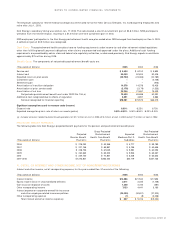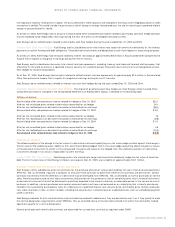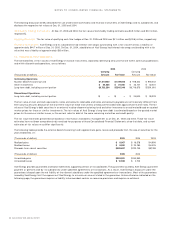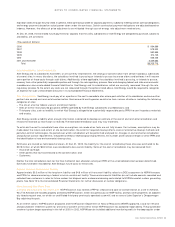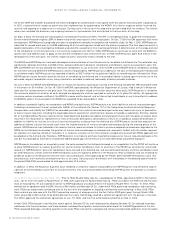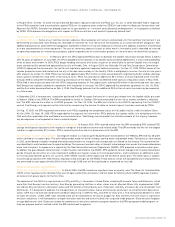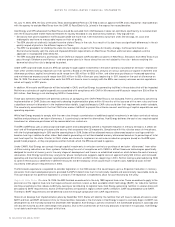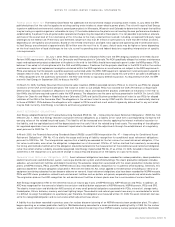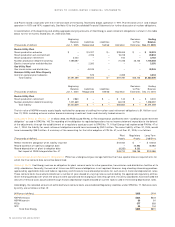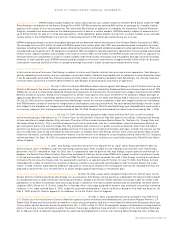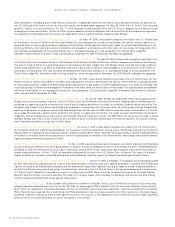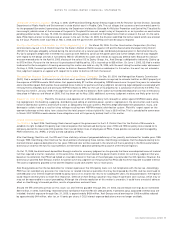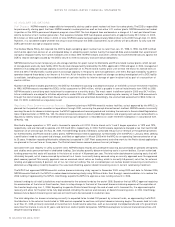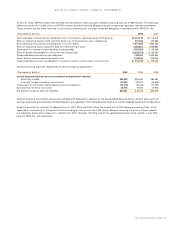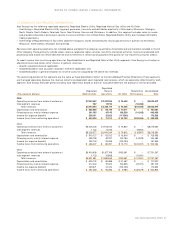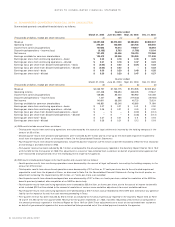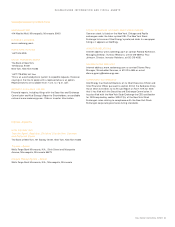Xcel Energy 2005 Annual Report Download - page 75
Download and view the complete annual report
Please find page 75 of the 2005 Xcel Energy annual report below. You can navigate through the pages in the report by either clicking on the pages listed below, or by using the keyword search tool below to find specific information within the annual report.Federal Clean Water Act
The federal Clean Water Act addresses the environmental impact of cooling water intakes. In July 2004, the EPA
published phase II of the rule that applies to existing cooling water intakes at steam-electric power plants. The rule will require Xcel Energy
to perform additional environmental studies at several power plants in Minnesota, Wisconsin and Colorado to determine the impact the facilities
may be having on aquatic organisms vulnerable to injury. If the studies determine the plants are not meeting the new performance standards
established by the phase II rule, physical and/or operational changes may be required at these plants. It is not possible to provide an accurate
estimate of the overall cost of this rulemaking at this time due to the many uncertainties involved, including unresolved third-party legal
challenges to the federal rule. Preliminary cost estimates range from less than $1 million at some plants to more than $10 million at others,
depending on site-specific circumstances. Based on the limited information available, total capital and operating and maintenance costs
to Xcel Energy are estimated at approximately $30 million over the next five to 10 years. Actual costs may be higher or lower depending
on the final resolution of legal challenges to the rule, as well as pending state and federal decisions regarding interpretation of specific
rule requirements.
PSCo Notice of Violation
On July 1, 2002, PSCo received a Notice of Violation (NOV) from the EPA alleging violations of the New Source
Review (NSR) requirements of the CAA at the Comanche and Pawnee plants in Colorado. The NOV specifically alleges that various maintenance,
repair and replacement projects undertaken at the plants in the mid- to late-1990s should have required a permit under the NSR process. PSCo
believes it has acted in full compliance with the CAA and NSR process. It believes that the projects identified in the NOV fit within the routine
maintenance, repair and replacement exemption contained within the NSR regulations or are otherwise not subject to the NSR requirements.
PSCo also believes that the projects would be expressly authorized under the EPA’s NSR equipment replacement rulemaking promulgated in
October 2003. On Dec. 24, 2003, the U.S. Court of Appeals for the District of Columbia circuit stayed this rule while it considers challenges to
it. PSCo disagrees with the assertions contained in the NOV and intends to vigorously defend its position. As required by the CAA, the EPA
met with Xcel Energy in September 2002 to discuss the NOV.
On March 10, 2005, the Rocky Mountain Environmental Labor Coalition (RMELC) provided notice to PSCo of its intent to sue PSCo for alleged
violations of the CAA at the Comanche plant. The notice of intent to sue alleges PSCo has violated the CAA’s Prevention of Significant
Deterioration regulations based on allegations that maintenance, repair and replacement projects undertaken at the plants in the mid- to
late-1990s should have required a permit under the NSR process. The allegations are the same as those presented in the NOV. On June 9, 2005,
Citizens for Clean Air and Water in Pueblo/Southern Colorado (CCAP) and Leslie Glustrom provided notice of intent to sue PSCo for alleged
violations of the CAA at the Comanche Plant. The allegations in the notice of intent to sue by CCAP and Ms. Glustrom are substantially identical
to those of RMELC. PSCo believes the allegations with respect to PSCo are without merit and will vigorously defend itself in any suit which
may be filed. Currently, Xcel Energy is not able to estimate any potential loss.
ASSET RETIREMENT OBLIGATIONS
Xcel Energy adopted Statement of Financial Accounting Standard SFAS No. 143 – “Accounting for Asset Retirement Obligations” (SFAS No. 143)
effective Jan. 1, 2003. Xcel Energy records future plant removal obligations as a liability at fair value with a corresponding increase to the
carrying values of the related long-lived assets. This liability will be increased over time by applying the interest method of accretion to
the liability, and the capitalized costs will be depreciated over the useful life of the related long-lived assets. The recording of the obligation
for regulated operations has no income statement impact due to the deferral of the adjustments through the establishment of a regulatory
asset pursuant to SFAS No. 71.
In March 2005, the Financial Accounting Standards Board (FASB) issued FASB Interpretation No. 47 – “Accounting for Conditional Asset
Retirement Obligations” (FIN No. 47) to clarify the scope and timing of liability recognition for conditional asset retirement obligations
pursuant to SFAS No. 143. The interpretation requires that a liability be recorded for the fair value of an asset retirement obligation, if the
fair value is estimable, even when the obligation is dependent on a future event. FIN No. 47 further clarified that uncertainty surrounding
the timing and method of settlement of the obligation should be factored into the measurement of the conditional asset retirement obligation
rather than affect whether a liability should be recognized. Xcel Energy implemented FIN No. 47 as of Dec. 31, 2005. Included in these financial
statements is the recognition of a cumulative change in accounting and disclosure of the liability on a pro forma basis.
Recorded Asset Retirement Obligations (ARO)
Asset retirement obligations have been recorded for nuclear production, steam production,
electric transmission and distribution system, natural gas distribution system and office buildings. The steam production obligation includes
asbestos, ash-containment facilities and decommissioning. The asbestos recognition associated with the steam production includes certain
plants at NSP-Minnesota, PSCo and SPS. NSP-Minnesota also recorded asbestos recognition for its general office building. Generally, this
asbestos abatement removal obligation originated in 1973 with the Clean Air Act, which applied to the demolition of buildings or removal of
equipment containing asbestos that can become airborne on removal. Asset retirement obligations also have been recorded for NSP-Minnesota,
PSCo and SPS steam production related to ash-containment facilities such as bottom ash ponds, evaporation ponds and solid waste landfills.
The origination date on the ARO recognition for ash-containment facilities at steam plants was the in-service date of various facilities.
Xcel Energy recognized an ARO for the retirement costs of natural gas mains at NSP-Minnesota, NSP- Wisconsin and PSCo. In addition, an
ARO was recognized for the removal of electric transmission and distribution equipment at NSP-Minnesota, NSP-Wisconsin, PSCo and SPS.
The electric transmission and distribution ARO consists of many small potential obligations associated with PCBs, mineral oil, storage tanks,
treated poles, lithium batteries, mercury and street lighting lamps. These electric and natural gas assets have many in-service dates for which
it is difficult to assign the obligation to a particular year. Therefore, the obligation was measured at Dec. 31, 2005. The asset retirement cost was
set to this recognized obligation and no cumulative effect adjustment was shown.
A liability has also been recorded in previous years for nuclear decommissioning of an NSP-Minnesota steam production plant. This plant
began operating as a nuclear production facility in 1964 before being converted to a steam production peaking facility in 1969. For the nuclear
assets, the asset retirement obligation is associated with the decommissioning of two NSP-Minnesota nuclear generating plants, Monticello
XCEL ENERGY 2005 ANNUAL REPORT 73
NOTES TO CONSOLIDATED FINANCIAL STATEMENTS


